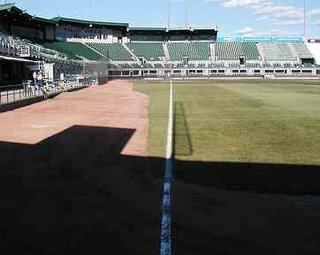Dreaming
EDMONTON, October 11, 2015 (CP) – The Edmonton Cracker Cats take the field tonight against the Oakland Athletics in the American League Championship Series.Other than a bit of whimsical hometown boosterism, what’s the point? It’s simple, really: while this scenario is rendered impossible by the government-sanctioned cartel that is MLB, it’s actually happened in European football.
The match at Telus Field will mark the first time a major league playoff series has been played in western Canada.
A hitter-friendly stadium, Telus was expanded to seat 22,000, but remains the smallest ballpark in the league.
Its short right porch, moved out to the league-minimum 325 feet when the Cracker Cats joined the AL in 2010, has led to a club stacked with some of baseball’s finest left-handed hitters.
They are expected to challenge 29-year-old Athletics’ ace Craig Italiano in tonight’s contest.
In 1997, ceramic tile magnate Fernando Roig bought Spanish Segunda División club Villareal. There was little reason to take notice.
Villareal had been a regional or third-division club for most of its history, cementing a second division foothold in the early 1990s. Headquartered in a town of 47,000, the team played in the tiny Estadio El Madrigal, which seated just 3,500.
Fast forward nine years, and the now Primera División club is set to face Arsenal in the semi-final of the Champions League. Two weeks from Tuesday, their home leg will be played in a capacious El Madrigal, which was expanded to seat half the town’s population (attendance typically hovers around 14,000, but this match will be played to a full house).
Roig’s success can be chalked up to club’s investments in facilities, players and development. The expanded stadium is home to Europe’s largest collection of expatriate Argentineans, with a few other brand-name South Americans thrown in for good measure. Elite South American players are cheaper to sign than locals, Doig claims.
The most important investment, though, has been made within. The Guardian reports that Roig “bought 70,000 square metres of an old orange grove from the council and invested €42m (£30m) in turning it into an academy with a residency for young players. Now Villarreal have as many under-16 internationals as Barcelona or Real Madrid, reflecting their commitment to a footballing model.”
Is there a good reason this can’t happen here – or in any other community?
Edmonton’s improbably-named baseball club already plays in a 9,000-seat stadium, in an immediate-market that’s 20 times Vila-real’s population.
While glaringly deficient in orange grove capacity, the community has a surplus of under-developed land ready for conversion into a year-round indoor training centre.
But unlike football, there’s no point to local owners investing in player development and free-agent signings. No matter how good the home team gets, there’s nowhere else for it to play.
Introducing tiered leagues into North American baseball, hockey or football is one of those quirky ideas sportswriters use to fill column inches when nothing else is going on. It’s about as likely as seeing the gridiron converted into metric (Question: would Superbowl tickets on the 45 metre-line command the same dollar premium?).
But periodically a European Horatio Alger story reminds us that the idea deserves to be taken seriously.
It’s more intellectually honest, dividing teams into divisions based on their ability to perform, and removing the beginning-of-the-season fiction that all clubs in a sport have a shot at that year’s title.
And it does a better job of delivering free-market-style access to the elite championships: invest in your club, work your way up, and your team can play among the elite.
It’s time for Ragged Dick to come home to America.

Telus Field (above): the next El Madrigal?




1 Comments:
Great post, Avi.
I was talking to a friend the other day, and bemoaning the fact that we are stuck with the Cracker Cats. I never really appreciated the Trappers until they were gone, althought I think part of the reason for that is that I used to work in the concession stand at John Ducey, and simply couldn't stand the horror of returning. To think that our closest Major League teams are in Seattle and St. Paul breaks my heart. That is still too far away.
I like how your dream only went as far as October 11 and the ALCS. Is it because you simply could not imagine a World Series matchup between the Cats and the Expos (who would of course have their team back by then) in Edmonton on October 31st?
Post a Comment
<< Home